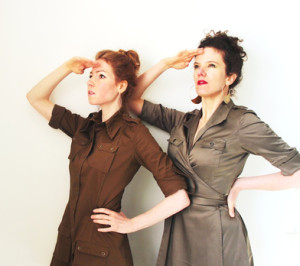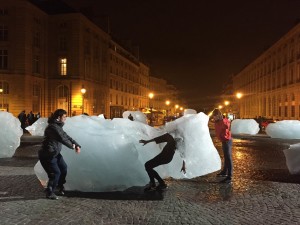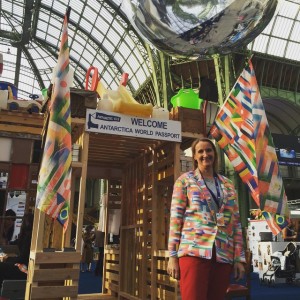 Here in Paris, international leaders wrangle about how to address the effects of climate change in ways that are both globally expansive and equitably conceived; the debate often focuses on measures that would stall the rising temperature of the earth’s core. Those ‘measures’ are of course complex, ambiguous, and under-felt for many of the world’s leaders and the world’s citizens, a fact that makes the hope of deploying new science to instill new behavior uncertain as well.
Here in Paris, international leaders wrangle about how to address the effects of climate change in ways that are both globally expansive and equitably conceived; the debate often focuses on measures that would stall the rising temperature of the earth’s core. Those ‘measures’ are of course complex, ambiguous, and under-felt for many of the world’s leaders and the world’s citizens, a fact that makes the hope of deploying new science to instill new behavior uncertain as well.
Meanwhile, outside of the inner circle of COP21, a variety of other circles spiral. Paris is teeming with business leaders, environmental activists, and NGO representatives. Some share ideas for new ventures; others share the voices of populations who are affected most adversely by climate change — and who are often the least likely to be represented in this global conversation. Some of the most potent, imaginative, and moving of these gatherings involve artists who use every element of an artistic toolkit to convey “the urgency, value, and opportunities of a transition away from fossil fuels.” That quote is from the organizers of ArtCOP21, a platform that hosts afternoon exhibits, public dialogues, interviews, and performances inside the ample spaces of Gaite Lyrique from November 30 to December 10. “To truly meet the climate challenge,” says ArtCOP21, “we need to get creative.” Of course, “creativity” means different things to different people, but the context of climate change needs extra powers of imagination. All of our conventional understandings of space, time, and human interaction seem to need complete recalibration.
Indeed, within and outside ArtCOP21, one can find artists using a range of forms—film, sculpture, installation, photography, performance, poetry, fiction, and more—in projects that vary in sensibility and goal. The environmental fashion designer, Lucy Orta, visited ArtCOP21 to discuss her explorations of “body architectures.” She elaborated on her creation of clothing designs that do double duty as environmental aid or — in the words of art scholar and Berkeley alum, Jennifer Johung – as “replacements of home.” Pants, ponchos, and hats expand and transform into carriers, sleeping bags, and temporary shelters; Orta’s work thus recalibrates conventional distinctions between inside and outside, collapsing the scale of the body and the scale of the home.
The artist Mel Chin – much beloved in many circles of socially-engaged art – appeared at ArtCOP21 as well. Chin flew in Inuit collaborators from Greenland as well as the writer and filmmaker Gretel Ehrlich (author, most recently, of “Rotten Ice: Traveling by dog sled in the melting Arctic” in Harper’s Magazine): together he and NPR correspondent, Neal Conan, shared stories, photographs, and films that exemplified the interdependence of two apparently independent regions. “Paris” and “the Arctic” sat next to each other in a poignant, if under-recognized, intimacy.
 Meanwhile, Berkeley alumna, Heidi Quante, and her collaborator, Alicia Escott, took another creative tack, installing a parody of environmental bureaucracy titled The Bureau of Linguistical Reality. Dressed in ranger garb, Quantes and Escott explore the language of environmental consciousness, inviting participants to invent new words to help us isolate the complex processes that allow us to face or to ignore the spatial and durational scale of an eroding planet. “Blissonance,” for instance, mixes “bliss” and “dissonance” to describe moments when an “otherwise blissful experience is disrupted by the recognition that , one is having an adverse impact on the place” one enjoys.
Meanwhile, Berkeley alumna, Heidi Quante, and her collaborator, Alicia Escott, took another creative tack, installing a parody of environmental bureaucracy titled The Bureau of Linguistical Reality. Dressed in ranger garb, Quantes and Escott explore the language of environmental consciousness, inviting participants to invent new words to help us isolate the complex processes that allow us to face or to ignore the spatial and durational scale of an eroding planet. “Blissonance,” for instance, mixes “bliss” and “dissonance” to describe moments when an “otherwise blissful experience is disrupted by the recognition that , one is having an adverse impact on the place” one enjoys.  “Pre-traumatic stress disorder” describes the condition of someone who anticipates a dystopian future while observing a “world around them not making necessary precautions.” Other terms have been coined in the many languages of the Bureau’s “clients”; most are compound words — e.g. Sous Traite Conscience, Shinrin-yoku — that attempt to define a thoroughly ambivalent nexus of emotions and behaviors.
“Pre-traumatic stress disorder” describes the condition of someone who anticipates a dystopian future while observing a “world around them not making necessary precautions.” Other terms have been coined in the many languages of the Bureau’s “clients”; most are compound words — e.g. Sous Traite Conscience, Shinrin-yoku — that attempt to define a thoroughly ambivalent nexus of emotions and behaviors.
In other spaces, climate artists have been “getting creative” in other ways. The extraordinary filmmaker, Charles Ferguson (also a Berkeley alum) deploys a panoramic landscape in “Time to Choose.” Connecting the grand scales of planetary transition with individual volition on the ground, Ferguson made the full film available to the world as a free live stream during the first day of COP21. The Nordic environmental artist, Olafur Eliasson, installed “Ice Watch” in front of the Paris Pantheon, assembling twelve large blocks in a clock-like circle on the stone plaza. “Watch” carries the sense of both observation and duration, providing visitors with an opportunity to confront the speed with which life on the planet is changing. While many environmental artists use melting ice as a resonantly metaphoric material, the fact that Eliasson’s ice is sourced from the melting fjords of Greenland makes his project all the more unsettling. The white chunks seem almost sentient as they dissolve; like beached animals removed from their natural habitat, they die before us, provoking the uncanny wish that they could somehow be put back. As summit leaders continue deliberations in a city that endured terrorist attacks only three weeks ago, artists found new ways to dramatize the stakes for varied member of the world’s population.
“Watch” carries the sense of both observation and duration, providing visitors with an opportunity to confront the speed with which life on the planet is changing. While many environmental artists use melting ice as a resonantly metaphoric material, the fact that Eliasson’s ice is sourced from the melting fjords of Greenland makes his project all the more unsettling. The white chunks seem almost sentient as they dissolve; like beached animals removed from their natural habitat, they die before us, provoking the uncanny wish that they could somehow be put back. As summit leaders continue deliberations in a city that endured terrorist attacks only three weeks ago, artists found new ways to dramatize the stakes for varied member of the world’s population.
New security measures mean that Parisians cannot use a familiar performance form—the street protest—to share their views. However, the French artist JR and the film-maker Darren Aronofsky de-familiarized that form to stunning effect in “The Standing March,” projecting hundreds of faces and bodies from around the world and using the iconic building of the Assemblée Nationale as a three dimensional screen. This march is all the more effective for having been arrested, stalling and installing this mass of bodies so that they can watch and be watched simultaneously.
Writer and Berkeley alum, Rebecca Solnit, described Aronofsky’s work and other events as a “day of phantoms,” where the phantoms of 130 killed on November 13 mingled with the phantoms of those forbidden to march in the weeks after. Of course, the most potent symbol of artistic protest came about in an action without artistic signature. On November 29, the first day of COP, 10,000 pairs of empty shoes appeared as site-specific installation where the bodies of protesters might have been. They served—and still serve—as a visceral reminder of bodies taken and of the bodies that remain. Creative activation surrounds COP21, provoking reflections that are intimate and gigantic, poignant and ironic, all toward activating a new consciousness of the future conditional.
Addendum: As part of Shannon Jackson’s report from Paris, we’ll highlight UC Berkeley-related projects produced for ARTCOP21 below:
Berkeley News: December 11,2015
Poet, alumna: Spoken word on a devastating superstorm
Flipino American poet Isabella Avila Borgeson, a recent UC Berkeley graduate in ethnic studies, is one of four spoken word artists chosen to perform in conjunction with climate talks now going on in Paris. Read more here.

